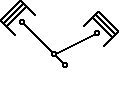|
|
Two-cylinder V-engine


| Always pay attention to the crank-pin on crank shaft of the V-2 |
The two-cylinder V-engine is now only found in motorcycles, here however, very often, and with all possible cyl. angles (see below). The two pistons are not always connected to one crank-pin. Often there two, which are
offset by the cylinder angle. This can be seen in the above stroke-diagram. An even distribution off the power-strokes can only occur when the movement of the pistons in their sleeves is exactly even. Nevertheless, first-
and second degree mass forces still develop here. As far as smooth running is concerned, the V-twin is, by no means, a role model.
| The vibrations are worse, the handling is better than the boxer engine |
In motorcycle construction, the unfiltered vibrations from the engine are still quite often passed on to the rider. This is due to the often static engine mountings, which transfer the vibrations to the entire vehicle. The width
of the motorcycle engine, because of the possible banking angle and the achievement of a low mounting- thus a low center of gravity, is important. This is where the V-twin can play it's trump card.
| Transverse- or straight mounted, both have advantages and disadvantages |
The cooling of the straight mounted engine, with it's cylinders directly in the wind, is perfect. Then however, the drive-train to the rear wheel is somewhat more complicated. Should the engine be transverse mounted, the
primary- and secondary drive are no problem, However, if air cooled, the rear cylinder then recieves less cooling from the wind-flow. In this case, liquid
cooling would be
helpful. Thereby, the width of the engine is small and the torque support from the engine occurs in the right direction.
| The V-2 can be had with a large cubic capacity and relatively low RPMs |
Those who believe that motorcycle engines are always small capacity and high revving units, may be in for a surprise as far as the V-twins are concerned. Some of them have a total cubic capacity of 2 liters or more and
- appropriately - the low price valve operation through pushrods and a low lying camshaft. The RPM level is then like that of a motor car engine,
or in fact, even lower. 05/09
| Cylinder angle according to the manufacturers |
| Aprilia | 60° |
| Ducati | 90° |
| Harley-Davidson | 45°/60° |
| Honda | 52°/80° |
| Indian | 42° |
| Mercedes | 72° |
| S&S | 45°/56,25° |
| Suzuki | 75° |
| Vincent | 47° |
|
|